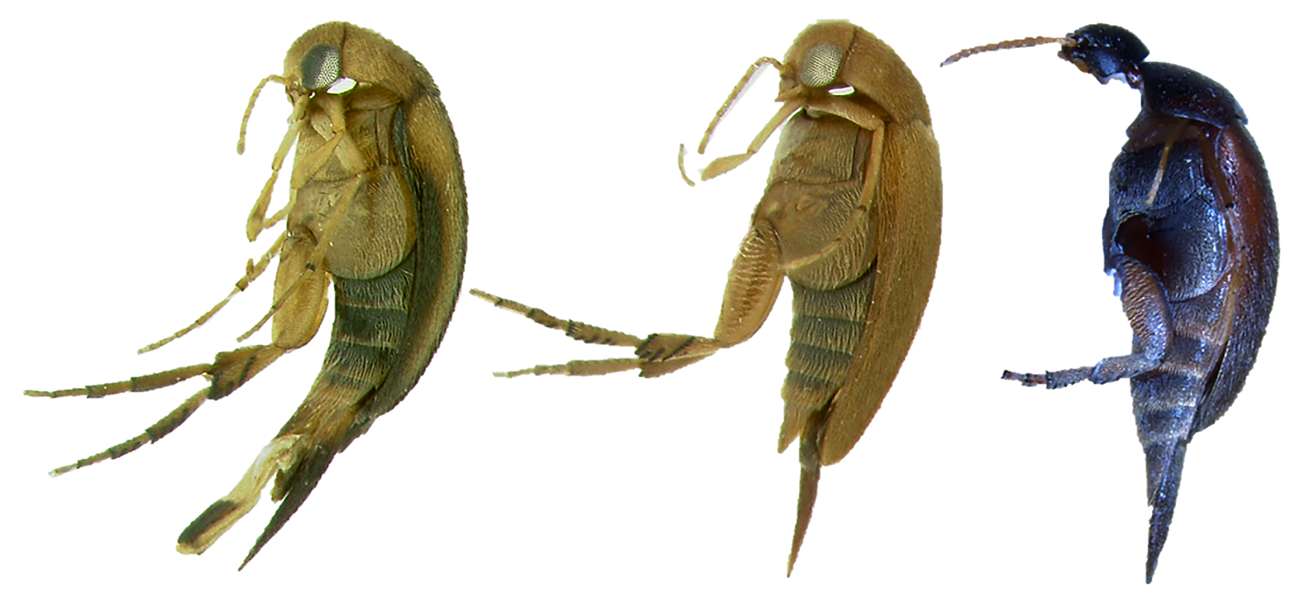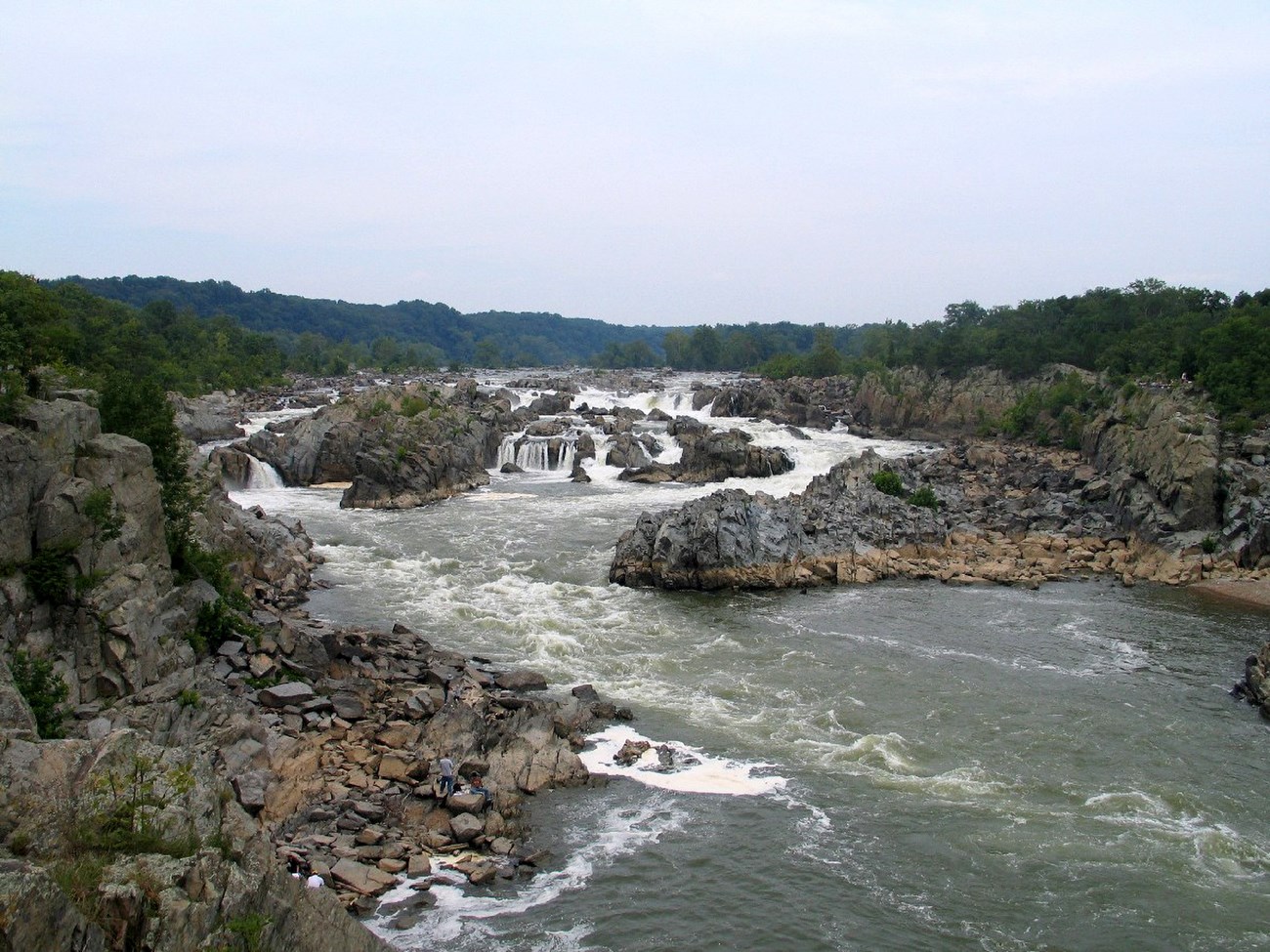Last updated: November 19, 2022
Article
An Urban Biodiversity Refuge Yields Four Beetle Species New to Science
Inside the Washington Beltway lies a portion of the Potomac Gorge, a haven for thousands of animals and plants. Some are yet to be described.
By Brent Steury

Image credit: NPS / Brent Steury
The Capital Beltway encircles Washington, DC, like a NASCAR circuit around an infield. The area it encloses is filled with 256 square miles of urban sprawl. There are 20 colleges, more than 80 museums, thousands of office buildings, and 1.73 million people living in hundreds of thousands of residences. A color, aerial view of this area is mostly gray. This is due to the millions of tons of asphalt and concrete that are a certain sign of human habitat. It’s not the kind of place someone interested in finding undiscovered animal species might think to look.
The Map of Life gives you a zero percent chance of finding a new species of bird, amphibian, reptile, or mammal inside the Capital Beltway.
In fact, the Map of Life gives you a zero percent chance of finding a new species of bird, amphibian, reptile, or mammal inside the Capital Beltway. But if you were stuck there and had a yen for natural things, you might notice a few verdant strands on an aerial map. This is a hopeful sign of places not made by humans. Amid the bleak urban landscape are small, emerald areas belonging to four National Park Service units: National Capital Parks-East, Chesapeake & Ohio Canal National Historical Park, George Washington Memorial Parkway, and Rock Creek Park.
Two of these jewels, the Chesapeake & Ohio Canal National Historical Park and the George Washington Memorial Parkway, buffer the sides of the Potomac Gorge. The gorge is a 15-mile stretch of the Potomac River with a steeply dissected landscape of bluffs, ravines, and floodplains. It is one of the best studied and most biodiverse areas in North America. Yet researchers are still discovering invertebrate species new to science there.
The Washington Biologists’ Field Club
Nestled near the heart of the Potomac Gorge is Plummers Island, a small island with towering oaks and tulip poplars that shade a rustic log cabin fondly known as the “Research Station.” A dilapidated brown and white wooden sign on the island proudly proclaims that it is “the most thoroughly studied island in North America.” The cabin is used as a meeting place by a small cadre of aging, intrepid biologists who are giddy about the unimaginable forms and colors that make up the diversity of life, as taxonomists generally are. These sharp-eyed species sleuths comprise the Washington Biologists’ Field Club.
A dilapidated brown and white wooden sign on the island proudly proclaims that it is “the most thoroughly studied island in North America.”
The club has been documenting the biodiversity of the 12-acre Plummers Island and nearby areas of the Potomac Gorge for 120 years. The plants and vertebrates are well known, but invertebrates are still largely unknown, despite published records of over 3,100 species from the island. For decades, these records were all we knew concerning the biodiversity of the Potomac Gorge.
However, the Chesapeake & Ohio Canal National Historical Park and George Washington Memorial Parkway have allied with members of the field club to study the gorge’s invertebrates. In 2006, both parks and The Nature Conservancy conducted the Potomac Gorge BioBlitz, a three-day inventory that documented 440 invertebrate species previously unrecorded from the gorge. Surveys of nearby areas in the Potomac Gorge during the last 15 years have recorded 1,584 species not yet documented from Plummers Island.
All-Taxa Inventory Documents More than Ever Imagined
Building on the success of the bioblitz, George Washington Memorial Parkway started a multi-year all-taxa biodiversity inventory. Husband and wife team Winifred Hallwachs and Daniel Janzen originally envisioned this type of study for a site in Costa Rica, but the study was later moved to the Great Smokies. An integral part of the park’s all-taxa study is a Bug Lab. This lab is powered by citizen scientists who sort captured insects into biological taxonomic groups.
The all-taxa inventory has generated 58 peer-reviewed journal papers documenting 1,144 invertebrate species new to the Potomac Gorge. These include 203 species new to Virginia, eight new to the District of Columbia, four species recorded for the first time in North America, and 14 species new to science. Most of the insects discovered in the gorge belong to the taxonomic order Coleoptera, also known as the beetles. Researchers have documented 654 species of beetles, including five new to science. The largest families of beetles they have recorded are rove beetles (165 species), click beetles (60 species), and tumbling flower beetles (45 species). They have also documented new Potomac Gorge records of moths (221 species), sawflies (97 species), and caddisflies (66 species, including one new to science).
Some of these new species are found nowhere else on Earth.
Some of these new species are found nowhere else on Earth, such as the shorefly Hydrellia toma. This insect was described in 2010 by Wayne Mathis, curator emeritus at the Smithsonian Institution. It is known only from Clay Pond in Great Falls Park, at the extreme western end of the gorge. In 2021, we found four beetle species new to science in the Potomac Gorge. These were the first newly described beetle species from the Potomac Gorge since 1981, when now deceased field club member Terry Erwin described the small black ground beetle, Tachys potomaca.

Image courtesy of Brent Steury and Warren Steiner
The four recently described beetles from Potomac Gorge are all in the tumbling flower beetle family. One species, Mordellina wimbledon, is named after the Wimbledon tennis tournament and its champions (due to the shape of the insect’s front legs, which resemble tennis rackets). Another, Pseudotolida syphaxi, is named in honor of retired National Park Service employee Stephen Syphax. Mordellina washingtonensis is named in honor of the George Washington Memorial Parkway. The fourth is named Mordellistena virginica, after the Commonwealth of Virginia.

Image credit: NPS / Brent Steury
Can Urban Biodiversity Persist?
Estimates are that invertebrates make up over 90 percent of the world’s animal species, but they are also among the least studied due to their overwhelming abundance. In terms of diversity, biomass, and ecological dominance, invertebrates are major contributors to terrestrial ecosystems. They should be considered in conservation planning and natural resource management. Scientists have documented over 4,684 invertebrates from the Potomac Gorge. But we know little about the distributions, life cycles, host plant associations, and habitat preferences of each species. The papers published by the Washington Biologists’ Field Club and the 58 more recent journal articles document some aspects of the life histories of Potomac Gorge invertebrates. Still, we need many more human lifetimes of study to fully understand the complexities of this natural area.
The vision that John Muir, Teddy Roosevelt, and Stephen Mather had for the National Park Service was to protect natural areas unimpaired for future generations. A steeply sided segment of the Potomac Gorge is named Mather Gorge in honor of Stephen Mather. A plaque on the rim of the gorge honors the memory of this visionary, the National Park Service’s first director. But it is uncertain whether the biodiversity found here will persist unaffected by the surrounding urban landscape. Currently, a controversial bridge expansion threatens to diminish the biological value of the gorge.
It’s possible that future generations may only be able to read about the life that now fills the Potomac Gorge.
The published papers documenting the Potomac Gorge’s bountiful profusion of life serve as benchmarks, so that we can detect biodiversity’s decline. It’s possible that future generations may only be able to read about the life that now fills the Potomac Gorge. But these papers will show them how it looked at the turn of the century and provide a blueprint for restoration.
In terms of fascinating complexity, any insect rivals any structure made by humans. The lone fact that one is alive and the other is not should quickly end debate on the issue. We need a new generation of scientists to carry on the legacy begun by the Washington Biologists’ Field Club 120 years ago. There is much left to discover, even in the urban landscape of the Capital Beltway.
About the author
Brent Steury is natural resources program manager at George Washington Memorial Parkway.
Tags
- chesapeake & ohio canal national historical park
- george washington memorial parkway
- great falls park
- national capital parks-east
- rock creek park
- beetle
- beetles
- invertebrates
- new species
- potomac gorge
- plummers island
- biodiversity
- insects
- brent steury
- animals
- perspectives
- ps v36 n1
- park science magazine
- park science journal
